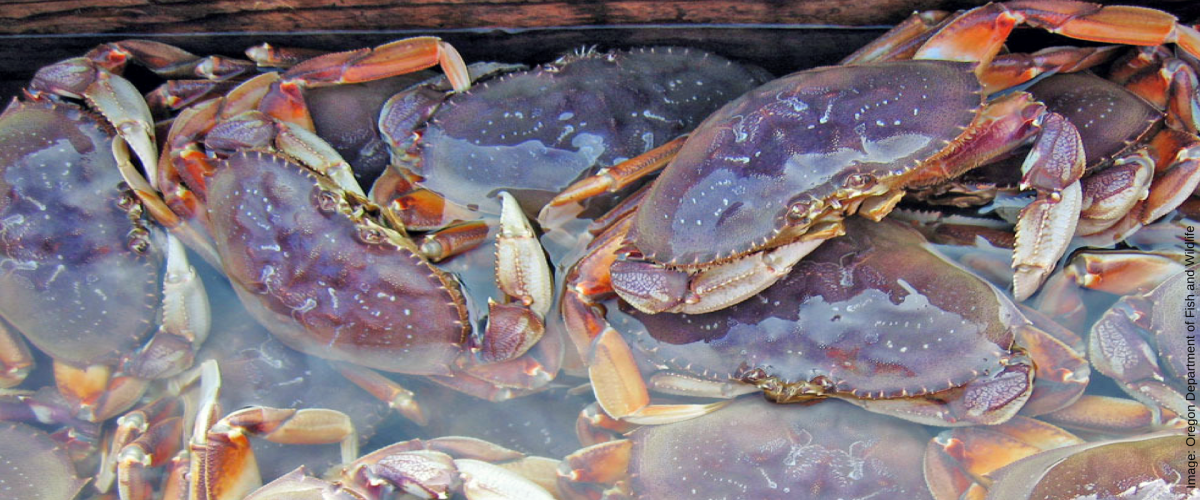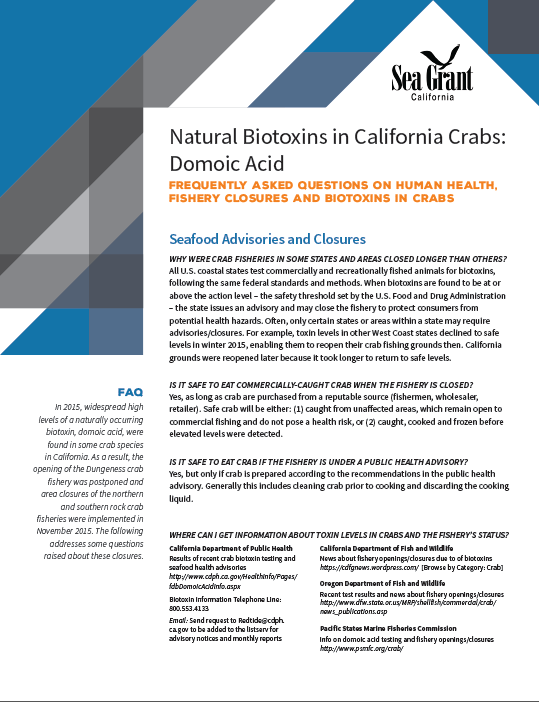Natural Biotoxins in California Crabs: Domoic Acid
In response to the 2015-2016 domoic acid event, California Sea Grant developed a consumer-facing Frequently Asked Questions (FAQ) document. Learn more about HABs, domoic acid, and seafood toxin monitoring efforts in California. For more general information on harmful algal blooms and safety of wild-caught seafood, see our new FAQ: Harmful algal blooms and wild-caught seafood in California.
In 2015, widespread high levels of a naturally occurring biotoxin, domoic acid, were found in some crab species in California. As a result, the opening of the Dungeness crab fishery was postponed and area closures of the northern and southern rock crab fisheries were implemented in November 2015. The following addresses some questions raised about these closures.
Seafood Advisories and Closures
Health and Safety
Biotoxins in Crabs
Seafood Advisories and Closures
Why were crab fisheries in some states and areas closed longer than others?
All U.S. coastal states test commercially and recreationally fished animals for biotoxins, following the same federal standards and methods. When biotoxins are found to be at or above the action level – the safety threshold set by the U.S. Food and Drug Administration – the state issues an advisory and may close the fishery to protect consumers from potential health hazards. Often, only certain states or areas within a state may require advisories/closures. For example, toxin levels in other West Coast states declined to safe levels in winter 2015, enabling them to reopen their crab fishing grounds then. California grounds were reopened later because it took longer to return to safe levels.
Is it safe to eat commercially-caught crab when the fishery is closed?
Yes, as long as crab are purchased from a reputable source (fishermen, wholesaler, retailer). Safe crab will be either: (1) caught from unaffected areas, which remain open to commercial fishing and do not pose a health risk, or (2) caught, cooked and frozen before elevated levels were detected.
Is it safe to eat crab if the fishery is under a public health advisory?
Yes, but only if crab is prepared according to the recommendations in the public health advisory. Generally this includes cleaning crab prior to cooking and discarding the cooking liquid.
Where can I get information about toxin levels in crabs and the fishery’s status?
Fishery-related biotoxin information is available from:
California Department of Public Health
Results of recent crab biotoxin testing and seafood health advisories
Biotoxin Information Telephone Line: 800.553.4133
Email: Send request to Redtide@cdph.ca.gov to be added to the listserv that provides advisory notices and monthly reports
California Department of Fish and Wildlife
News about fishery openings/closures due to elevated levels of biotoxins
[Browse by Category: Crab]
Oregon Department of Fish and Wildlife
Recent test results and news about fishery openings/closures
Pacific States Marine Fisheries Commission
Information on domoic acid testing and fishery openings/closures in California, Oregon, Washington
Health and Safety
How likely am I to be exposed to this toxin by eating crabs?
Health advisories are issued and fishery closures are implemented to protect the public from biotoxins when needed. Domoic acid is not always present, so typically crab can be enjoyed without concern. However, even when the toxin is present, the levels can vary tremendously among crabs from the same or different areas, with some crabs above and others below the action level. Further, the way you prepare the crab, which parts you consume, and the amount you consume all can influence exposure to the toxin (see next question). The public health advisories – and the particular guidance they provide – are developed to reduce potential exposure to this toxin.
How many contaminated crabs would I have to eat before I would get sick?
This remains largely unknown as information about the transfer of this toxin to humans through their consumption of crabs is extremely limited, and is based primarily on evidence from human consumption of mussels and razor clams and studies with mice. What is known is that the risk to humans depends on:
- The level of toxin in the crab. Toxin levels can vary greatly among crabs, even those from the same area.
- How the crabs are prepared. Domoic acid is not destroyed by heat, but it is water-soluble. This means boiling crab in water (liquid) can reduce domoic acid levels in the crab as they leach out into the water. This is why it is essential to discard that liquid; do not use it to prepare sauces, soups or other food items. Note that steaming, grilling, stir-frying and baking likely do not have the same benefit because there is very little liquid available for the toxin to leach into during these cooking processes.
- Which parts and how much crab is consumed. The toxin is highly concentrated in the internal organs (viscera, guts, crab butter) of crabs. If people avoid eating and cooking with these parts of the crab, their risk of exposure to the toxin will be greatly reduced.
What will happen to me if I eat contaminated crab?
Within 24 hours of ingestion, symptoms of domoic acid exposure may include vomiting, nausea, diarrhea and abdominal cramps. In more severe cases, neurological symptoms develop within 48 hours and may include headache, dizziness, disorientation, loss of short-term memory, motor weakness, seizures, cardiac arrhythmias, coma and possibly death. Given the potential for short-term memory loss, the associated sickness is called Amnesic Shellfish Poisoning, or ASP.
No cases of ASP from eating crab have been documented, only cases from eating mussels and razor clams. However, ASP may go unreported or be attributed incorrectly to other illnesses with similar symptoms.
I may not always be able to check the advisory hotline or website. What steps can I take to minimize my health risk from domoic acid while still eating crab?
- Buy crab only from a reputable source and check for public health advisories and fishery closures before you consume recreationally-caught crab.
- Clean the crab – remove the internal organs including the viscera/crab butter/guts – before cooking.
- Boil the cleaned crab and discard the cooking liquid (do not use it in sauces, etc.).
Biotoxins in Crabs
Is this a new problem in California?
No. High levels of domoic acid have been found in the water and in crabs from time to time – particularly in the Santa Barbara Channel and Monterey Bay regions – since the California Department of Public Health began monitoring for it in 1991. Fisheries have been closed in very few cases, with public health advisories typically posted for consumption of certain seafood obtained from specific areas of the state.
The event of 2015-2016 was unprecedented in that it affected nearly the entire West Coast from Southern California to Alaska. The domoic acid-producing algal bloom began in Summer 2015 and continued for many months with very high levels of domoic acid accumulating in most of the crabs sampled during this time. The bloom dissipated in fall 2015 and the toxin was no longer found in the water. However, elevated levels of the toxin persisted in crabs for many months.
How do crabs obtain this toxin?
Domoic acid is produced by microscopic plants (algae) in the water column. These algae are consumed by aquatic animals such as mussels, clams, scallops, anchovies and sardines that strain food particles – including toxic algae -- from the water. The toxin becomes concentrated in these ‘filter-feeding’ animals, which are eaten, in turn, by crabs. The toxin is then transferred to humans and other animals when they consume the affected crabs.
How long will the crabs contain domoic acid?
This depends on several factors including:
- The level of toxin already present in the crabs
- The levels of toxin that remain in the water and in the food that the crabs are consuming
Though scientific understanding of these factors is increasing, currently there is no reliable means to predict when toxin levels in crabs will decrease to safe levels. Thus, crabs must continually be tested to determine when advisories and closures can be lifted.
What does the toxin do to the crabs?
Domoic acid does not appear to affect the health of the crabs. The crabs just act as ‘carriers’ of the toxin. The toxin is problematic primarily for seabirds and mammals including humans, seals and dolphins whose neurological systems are susceptible to this toxin.
Additional Information
For more information about biotoxins and California commercial fisheries visit:
- California Department of Public Health: Domoic Acid: Frequently Asked Questions (PDF)
- Food and Agriculture Organization (FAO): Marine Biotoxins: Amnesic Shellfish Poison
- European Food Safety Authority Scientific Opinion: Marine Biotoxins in Shellfish – Domoic Acid
- California Sea Grant: Discover California Commercial Fisheries

